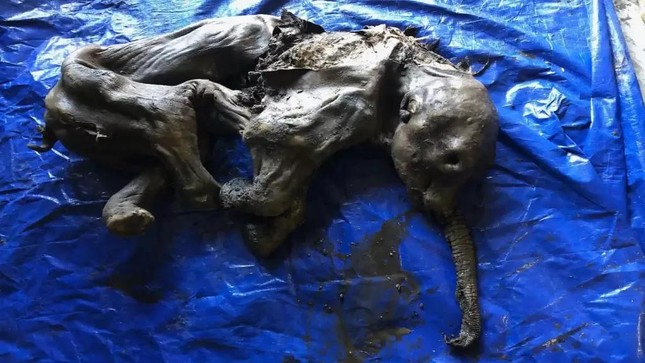The 4.5 foot long baby was just one month old at the time of death.
The baby woolly mammoth, measuring 4.5 feet long and just one month old at the time of its death, has been remarkably mummified for 30,000 years. A miner in Canada’s Klondike gold fields uncovered this exceptionally preserved specimen from the permafrost. Officials have described the baby mammoth as “the most complete mummified mammoth found in North America.” Discovered in Eureka Creek, on the land of the Tr’ondëk Hwëch’in First Nation in Yukon, the animal was named “Nun cho ga,” which means “big baby animal” in the Hän language. Analysis indicates that the calf is female and roughly one month old at the time of death, similar in biological age to another woolly mammoth calf, known as “Lyuba,” which was found in Siberia in 2007 and is estimated to be 42,000 years old.

“As an ice age paleontologist, it has been a lifelong dream of mine to encounter a real woolly mammoth. That dream has come true today,” stated Grant Zazula, a paleontologist with the Yukon government’s Department of Tourism and Culture. “Nun cho ga is beautiful and ranks among the most remarkable mummified ice age animals ever discovered globally. I am thrilled to learn more about her.”
The remains were found when a mine worker digging near a creek in the Klondike gold fields south of Dawson City felt his front-end loader hit something unusual. He called his supervisor over, and together they uncovered the mummified mammoth buried in the mud. Work at the mine was halted so that two geologists could travel to the site, recover the remains of the extinct animal, and collect samples from the area.
“The incredible part is that within an hour of their arrival, the sky darkened, lightning began striking, and heavy rain poured down,” Zazula told the Canada Broadcasting Corporation (CBC). “If she hadn’t been recovered at that moment, she would have been lost in the storm.”
This isn’t the first instance of miners discovering mummified mammoths in this region. In 1948, partial remains of a calf nicknamed Effie were found at a gold mine in nearby Alaska. However, none of those earlier finds were nearly as well-preserved.
“It’s astonishing. I was breathless when they unveiled it from the tarp. We must all treat it with reverence,” said Tr’ondëk Hwëch’in Elder Peggy Kormendy in her statement.
The infant mammoth was discovered mummified in the muddy permafrost of a Yukon goldmine
Woolly mammoths roamed the frigid Arctic plains of northern Europe, Asia, and North America alongside wild horses, cave lions, and giant bison, disappearing as recently as 5,000 years ago, as previously reported by Live Science.
Had Nun cho ga reached adulthood, she could have stood about 13 feet (4 m) tall at the shoulder and would have possessed large, curved tusks to fend off threats.

The presence of grass in the infant’s stomach indicates that Nun cho ga may have been grazing when she died, possibly succumbing after wandering a bit too far from her mother’s view. This led her to become stuck in the mud and suffocate.
“The sequence from being trapped in the mud to burial happened very quickly,” explained Zazula.
Earth scientist Dan Shugar, an associate professor at the University of Calgary involved in the mammoth recovery, expressed on Twitter that uncovering the remains “was the most thrilling scientific experience I’ve ever had, by far.” He noted that the remains were preserved all the way down to the intestines and individual toenails.

